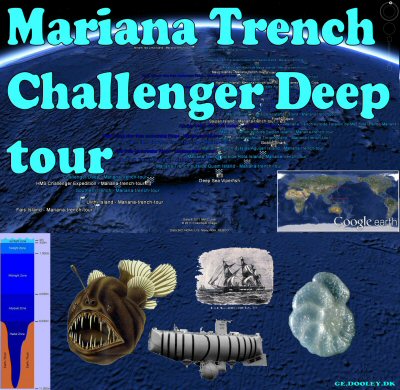Post by TomKjeldsen on Aug 22, 2015 12:40:47 GMT
Deepest part and place of the world's oceans. Mariana Trench and Ridge, with ridge islands and Challenger Deep. The Challenger Deep is the deepest surveyed point in the oceans, with a depth of at least 10,911 metres (35.797 feet). The exact depth is unknown, but 3 expeditions including the only manned dive in 1960 with the submarine Trieste, has measured depths of 10,902 to 10,916 meters. Sonar has recently measured 10,971 m (35.994 ft). The trench forms the boundary between two tectonic plates, where the Pacific plate is subducted beneath the small Mariana plate. It hard to imagine how deep the deepest parts of the oceans are. To illustrate this, the deepest known bottom of the trench is more than 2000 meters (6562 feet) deeper than the highest mountain in the world, Mount Everest is higher above sealevel. At the deepest bottom of the trench, around the depth of 10,911 metres (35.797 ft), the water column above produce a pressure of 1056 atmospheres, 1091 kg/sq cm, 1070 bar, 106997 kPa, 15519 psi (pounds per square inch), more than one thousand times the standard atmospheric pressure at sea level. The creatures that could live at these depths are few, as far as we know by our current exploration of the deep sea of the earth. On the other hand, the worlds oceans is the biggest and most unexplored part of the earth. It's more than likely that most wildlife down there still remains to be discovered. Still deep sea animals like the Viperfish, Giant Megamouth Shark, Blobfish, Goblin Shark, Angler Fish, Dragon Fish, Firefly Squid, Giant Isopod, Giant Squid, Gulper Eel, Vampire Squid, Sperm Whale, Giant Japanese Spider Crab, Frilled Shark and the Longnosed Chimaera have been spotted at very deep depths waters. Organisms like foraminifera, single-celled protists that construct shells, have been discovered near or at the bottom of the deepest part of the earth, the deep sea in the Challenger Deep.

bigger illustration/collage
About the "Mariana Trench tour": Take a tour along the islands that emerge up above sea level along the Mariana ridge as tectonic plates moves and underwater volcanoes reach the pacific sea surface. Dive thousands of feets and meters below surface in the Mariana trench and swim on to the reef of the islands. Take a dip and a view of the Challenger Deep with info on deep sea fish and organisms, the Trieste submarine diving to the bottom and the original spotting of 'the bottom of the world'. Enjoy! Tour creator: Tom Kjeldsen, created february 2009. Recommended to be viewed as a 'Play tour' in Google Earth (v5+) with terrain/ocean feature enabled.
-----
Some additional maybe informational, interesting youtube stuff:
Life in the Mariana Trench
video on youtube
The Trieste's Deepest Dive
video on youtube
Long Way Down: Mariana Trench
video on youtube
Challenger Deep at Mariana Trench dive in Google Earth (part of this file)
video on youtube
-----
Download a identical copy of the attached file below from here (suitable for non Google Earth Community members)![]()

This post is a re-post of this original 2009-02-13 Google Earth Community post![]()


bigger illustration/collage
About the "Mariana Trench tour": Take a tour along the islands that emerge up above sea level along the Mariana ridge as tectonic plates moves and underwater volcanoes reach the pacific sea surface. Dive thousands of feets and meters below surface in the Mariana trench and swim on to the reef of the islands. Take a dip and a view of the Challenger Deep with info on deep sea fish and organisms, the Trieste submarine diving to the bottom and the original spotting of 'the bottom of the world'. Enjoy! Tour creator: Tom Kjeldsen, created february 2009. Recommended to be viewed as a 'Play tour' in Google Earth (v5+) with terrain/ocean feature enabled.
-----
Some additional maybe informational, interesting youtube stuff:
Life in the Mariana Trench
video on youtube
The Trieste's Deepest Dive
video on youtube
Long Way Down: Mariana Trench
video on youtube
Challenger Deep at Mariana Trench dive in Google Earth (part of this file)
video on youtube
-----
Download a identical copy of the attached file below from here (suitable for non Google Earth Community members)

This post is a re-post of this original 2009-02-13 Google Earth Community post


